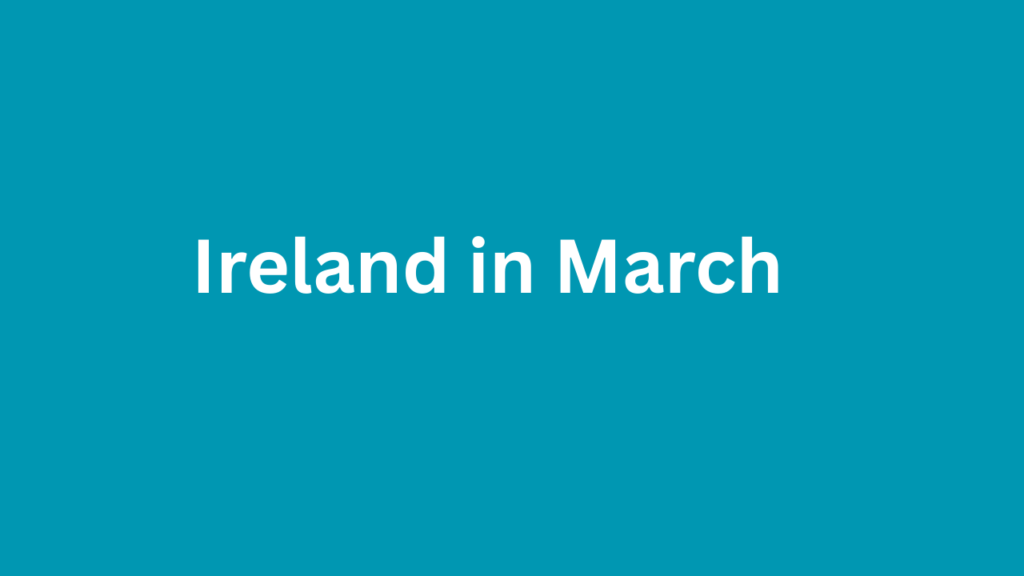Ireland is a country of dramatic landscapes, rich history, and vibrant culture. By March, the country begins to shake off the last remnants of winter and welcomes the early signs of spring. This transition makes March a fascinating month to visit: the weather starts to improve, days gradually lengthen, and cultural life picks up pace after the quieter winter months.
For travelers looking for fewer crowds than summer, affordable accommodations, and authentic experiences, March presents an ideal opportunity. From St. Patrick’s Day festivities to misty countryside walks and cozy pub evenings, Ireland in March offers a blend of winter’s quiet charm and spring’s emerging energy.
This article explores what it’s like to visit Ireland in March, including weather, attractions, events, travel tips, and personal insights to help you make the most of your trip.
Why Visit Ireland in March?
1. Experience Early Spring in Ireland
March marks the transition from winter to spring. Fields start to show hints of green, daffodils bloom along roadside hedges, and lambs appear in pastures. Unlike the crowded summer months, you can enjoy these sights peacefully and authentically.
2. Affordable Travel
March is still considered part of the shoulder season, so flights, accommodations, and car rentals are generally more affordable than in peak months like June and July. This allows travelers to enjoy Ireland without the high-season premiums.
3. Celebrate St. Patrick’s Day
Ireland comes alive around March 17th with St. Patrick’s Day celebrations. Dublin, Cork, and Galway host parades, music festivals, and cultural events that attract both locals and visitors. Experiencing this festival on the ground offers a once-in-a-lifetime insight into Irish culture, traditions, and community spirit.
4. Fewer Crowds at Major Attractions
While St. Patrick’s Day is busy in major cities, rural attractions, castles, and coastal sites remain relatively quiet. This makes it an ideal time to explore landmarks like the Cliffs of Moher, Kilkenny Castle, or the Ring of Kerry without the summer tourist rush.
Personal Note: During a March visit to Connemara, I experienced misty mornings and empty coastal trails. Unlike the summer months, I could stop at viewpoints freely, take photos, and enjoy the dramatic landscapes without crowds.
Weather in Ireland in March
March weather in Ireland is notoriously variable. It’s important to prepare for a mix of conditions.
- Average Temperatures: 4°C to 10°C (39°F to 50°F), making it slightly warmer than February but still cool.
- Rainfall: Ireland experiences frequent light rain and drizzle, with an average of 15–20 rainy days in March.
- Wind: Coastal areas can be windy, especially along the Wild Atlantic Way.
- Daylight: Around 11–12 hours by mid-March, with sunrise around 7:30 AM and sunset around 6:30 PM, providing more daylight for exploration.
- Snow: Rare, mostly limited to higher inland areas, but frost is possible.
Tip: Layered clothing, waterproof outerwear, and sturdy shoes are essential. A scarf and hat are useful for windy coastal walks.
What to Pack for Ireland in March
Packing strategically ensures comfort throughout the variable March weather:
- Waterproof jacket and windproof outer layers
- Sweaters, fleece, or thermal layers
- Comfortable, waterproof walking shoes or boots
- Scarf, hat, and gloves
- Umbrella (though often less useful in strong winds)
- Reusable water bottle
- Casual-smart clothing for pubs, cafes, and cultural events
Personal Tip: I always pack a small daypack for March trips to store layers and rain gear. This way, you can adjust quickly to the sudden weather changes typical of Irish spring days.
Things to Do in Ireland in March
Despite lingering cool weather, March offers diverse activities and experiences.
1. Explore Irish Cities
Dublin, Cork, Galway, and Limerick all offer indoor and outdoor attractions. Highlights include:
- Dublin: Trinity College and the Book of Kells, Guinness Storehouse, Dublin Castle
- Cork: English Market, Crawford Art Gallery, Shandon Bells
- Galway: Latin Quarter, Galway City Museum, Eyre Square
- Limerick: King John’s Castle, Hunt Museum
March allows for quieter exploration than summer, except during St. Patrick’s Day festivities.
2. Enjoy Cozy Pubs
Irish pubs are at their most inviting in early spring. Many feature live traditional music in the evenings, offering a warm, authentic atmosphere. Popular pubs in Galway, Dingle, and Kilkenny provide excellent food and entertainment.
Personal Note: On a March evening in Kilkenny, I discovered a small pub where locals gathered for traditional music sessions. The experience was far more intimate than tourist-heavy venues, offering insight into Ireland’s vibrant folk culture.
3. Castles and Historic Sites
Many castles and historic landmarks remain open in March:
- Kilkenny Castle: Offers both historic tours and seasonal gardens.
- Bunratty Castle & Folk Park: Perfect for learning about medieval Ireland.
- Malahide Castle: Just outside Dublin, with extensive gardens showing early signs of spring blooms.
Visiting these sites in March ensures fewer crowds and more time to explore.
4. Coastal and Countryside Walks
Ireland’s natural landscapes shine in March. Coastal walks and countryside trails are less crowded and offer dramatic vistas:
- Cliffs of Moher: Winter winds have subsided, but the landscape remains wild.
- Howth Cliff Walk near Dublin: Enjoy the early spring flowers and panoramic sea views.
- Ring of Kerry and Dingle Peninsula: Stunning scenery with fewer tourists than in summer.
- Connemara: Misty mountains and quiet trails create a mystical atmosphere.
Tip: Dress warmly and wear waterproof boots for muddy or slippery trails.
5. Festivals and Cultural Events
March features both traditional and contemporary Irish festivals:
- St. Patrick’s Day (March 17th): Parades, live music, street performances, and cultural events.
- Dublin Theatre Festival and local music events: Many cities host indoor arts and music programs in March.
- Local celebrations of Celtic traditions: Particularly in rural areas, St. Brigid’s crosses and other customs continue into early March.
Food and Drink in March
Winter-inspired comfort foods continue to dominate, while early signs of spring appear in local produce:
- Irish Stews: Lamb or beef stews remain a winter staple.
- Seafood: Fresh oysters, mussels, and fish are abundant along the coast.
- Seasonal Vegetables: Early spring greens like kale, cabbage, and potatoes are common.
- Baked Goods: Soda bread, brown bread, and pastries from local bakeries.
- Warm Drinks: Irish coffee and hot chocolate remain perfect companions for chilly evenings.
Personal Tip: I visited a Galway café in March and enjoyed fresh crab cakes paired with a steaming cup of Irish breakfast tea — the perfect blend of winter warmth and early spring freshness.
Travel Costs in March
March remains part of the shoulder season, offering cost advantages:
- Flights: Often cheaper than spring and summer, especially outside of St. Patrick’s Day week.
- Accommodation: Hotels and B&Bs are more affordable than peak months, particularly in rural areas.
- Car Rentals: Easier to book and less expensive than summer.
- Attractions: Entry prices remain standard, but shorter lines save time.
Tip: Book accommodations early if visiting Dublin or Cork during St. Patrick’s Day, as prices and availability can spike.
Transportation in March
- Public Transport: Reliable between cities and towns, though rural services may be less frequent.
- Driving: Roads are less congested than summer, but be mindful of wet and muddy rural roads.
- Walking: Cities are pedestrian-friendly; pack waterproof footwear.
Tip: Take advantage of longer daylight hours compared to January and February for scenic drives and outdoor exploration.
Common Concerns About Visiting Ireland in March
Q: Is March too cold?
While temperatures remain cool, it’s milder than winter months. With layers and waterproof gear, outdoor activities are comfortable.
Q: Will there be rain?
Yes — March is wet but not excessively so. Expect light rain or drizzle; occasional sunny spells are common.
Q: Are attractions open?
Yes — museums, galleries, castles, and major tourist sites are open. Some rural or seasonal attractions may have limited hours.
Q: Is St. Patrick’s Day too crowded?
Dublin and other major cities are busiest around March 17th. Smaller towns are less crowded, offering a quieter festival experience.
Pros and Cons of Visiting Ireland in March
Pros:
- Affordable flights, hotels, and rentals.
- Fewer crowds outside major cities during St. Patrick’s Day.
- Early spring landscapes and emerging greenery.
- Cozy pub culture and indoor music events.
- Opportunities to experience authentic local life.
Cons:
- Weather is variable and can be damp or chilly.
- Shorter daylight than late spring or summer.
- St. Patrick’s Day week can be crowded in cities.
- Some rural attractions may still be closed or limited.
A Personal Reflection on March in Ireland
I spent a week in March traveling from Dublin to Galway, with stops in Kilkenny and the Cliffs of Moher. Early mornings were misty, and occasional showers kept the countryside vibrant and green. In Dublin, I joined locals watching rugby in a pub — the atmosphere was electric and authentic. In Kilkenny, I wandered through the castle gardens, enjoying the early daffodils without any crowds.
What struck me most was the balance between quiet exploration and lively cultural experiences. March allowed me to experience Ireland’s landscapes and towns with both solitude and connection, making it one of my most memorable trips.
Final Thoughts
Ireland in March offers a unique combination of affordability, authentic experiences, and the first signs of spring. The weather may be unpredictable, but proper preparation allows you to enjoy both outdoor and indoor activities comfortably.
From St. Patrick’s Day celebrations to dramatic coastal walks and cozy pub evenings, March provides an opportunity to experience Ireland differently than in the busy summer months. It’s ideal for travelers who appreciate quieter landscapes, cultural immersion, and seasonal charm.
With careful planning, warm clothing, and an openness to the occasional shower, Ireland in March can be a deeply rewarding and memorable experience.

Hi, I’m Tanvir, the founder and author of Explore Ireland Now. With a deep love for Ireland and its rich culture, history, and landscapes, I created this site to share everything that makes this beautiful country worth exploring. Whether you’re a local looking for hidden gems or a traveler planning your next adventure, I provide insightful guides, tips, and recommendations to help you experience Ireland to the fullest.
From stunning landscapes to vibrant cities and quaint villages, Ireland is full of wonders waiting to be discovered. Through my personal experiences and research, I aim to bring you the most up-to-date information and inspiration for your journey.
Thank you for visiting Explore Ireland Now—I hope my content helps you uncover all that this incredible country has to offer! If you have any questions or need travel advice, feel free to reach out.



